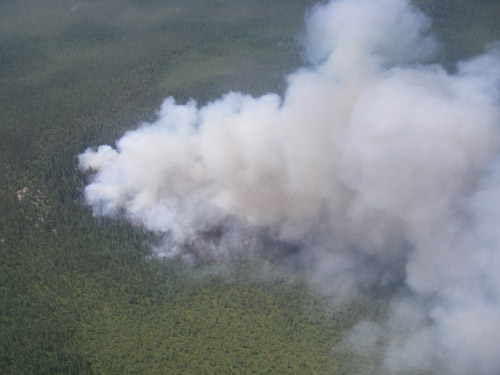
Forest Firefighter
Tiny Northern Town, ON
Male, 25
I have worked as a seasonal forest firefighter in the northern regions of Ontario, Canada for the past eight summers. The job is great for university students because it allows you to work the four month Summer break, it offers a solid challenge mentally and physically, and pays well. I have had many life-changing experiences working three week shifts in the woods, often 14 - 16 hours a day. We work mostly out of helicopters and in conjunction with water bombers.
Yes, there are three instances where forest firefighters should start fires. (1) Prescribed burn: where permitted, we will reduce the 'fuel loading' (amount of wood, grass, forest litter) in specific areas where humans are likely to inadvertently start fires in the future. This takes place in Provincial and National Parks mostly. In the 70s and 80s there were many prescribed burns that were coordinated with the forestry industry to burn recently cut slash blocks so that treeplanters would have greater success in reforestation. Many of these fires escaped the control lines, costing the government and industry a lot of money compared to alternative (i.e. scarification) and this has since been largely discontinued in Ontario. (2) Burnout operations: in Ontario we use three main tools to conduct burnouts ahead of an aggressive forest fire. There is the newer Northern Helitorch, which hangs below a light helicopter and spits napalm at the press of a button. The older Ontario Aerial Ignition Device (OAID) injects special pingpong balls filled with potassium permanganate with antifreeze (glycol) and then spits them out the side of the helicopter every few seconds. The resulting chemical reaction causes these "OAID balls" to burst into flame shortly after hitting the forest floor. The third device is for firefighters on the ground, the handheld "driptorch," which uses gravity and a wick to light a mixture of 3 parts diesel to 1 part unleaded gasoline. The theory behind a burnout operation is to burn from a natural or person-made barrier such as the edge of a lake or a bulldozer line, that way you can control the fire. The new fire, of lower intensity, is hopefully sucked into the aggressive main-fire, which demands more oxygen. When the two fires meet, there is an absence of fuel, and the fire behavior dies down. Now all you have to do is extinguish the edge, which is up against your natural or man-made barrier. Burnouts are also used to keep a convection-driven column from "laying down," which results in a lot of spot fires. In igniting strip fires on the flanks of the main fire (against lakes or rivers), the oxygen flow and intensity of the headfire is spread out to the sides, and the convection column "stands up." A big problem is when spot fires ignite past the burnout control lines, and then you have to be quick with waterbombers and helibuckets to douse those small blazes. If they get away from you, you have to start over and your fire is that much the larger. (3) Touch-up: sometimes there are "green islands" of trees within the burnt area, that have embers in their edges, and are near enough to the unburnt forest that, given the right winds, they could cause spot fires (see definition in question 1 above). Driptorches can be used to clean up these islands when the winds are favourable.
I had not done any firefighting before. I started when I was 18 years old and had worked previously doing recreational canoe tripping at summer camps and as a snowboard instructor. The important thing is to be comfortable and content living in the bush, probably next to a swamp, for weeks on end with the same team of firefighters. This means getting extremely dirty and not having anywhere to bath (wet wipes!), cooking your own meals and eating in a nylon bug tent, waking up at sunrise and working until sunset (sometimes 16 hours at the height of summer), being away from loved ones for weeks, not being able to plan when you will have time off, and getting destroyed by blackflies and mosquitoes. The actual firefighting is rewarding and exciting, it is these additional challenges that destroy some peoples' morale, which quickly poisons the work environment and leads to one salty seagull bringing down the whole team. It is also essential to have a positive-minded crew leader or crew boss to keep everyone looking on the bright side and leading by example. Each provincial program in Canada has its own relatively minor pre-hire training requirements, which are followed by extensive on-the-job training on both mock fires and real dispatches. In Ontario, you must be above the age of 18, and there are three pre-hire requirements: (1) SP100 Firefighter Course - offered by a number of private companies across Ontario. [80hours, 10 days] ~$900 This course covers the bare bones: basic fire behaviour theory, occupational safety, camp set-ups, handtool use, pumps and hose, radios, aircraft safety, and is almost impossible to fail. You will not be comfortable with any of the equipment after this course but should understand the basic concepts of firefighting and your role as a new firefighter. (2) Standard First Aid - offered by St. John's Amulance across Ontario. [Usually a 2 day intensive course] ~$150 (3) WFX-fit test - offered in most regions of Ontario at various points in the offseason. [A fitness test that simulates carrying hosepacks up steep terrain (up and down a steep ramp) and dragging fully charged hoselines (hose attached to a weighted sled). If you train specifically for it and have no medical impediments, you shouldn't have problem.] ~$150 As you can imagine, it being this easy to achieve the minimum requirements, the trainers at the SP100 will try to sell you additional courses which are *not* recognized by the Ontario Ministry of Natural Resources and are pointless cash grabs for the trainers. These include: Industry Canada's radio operator course, Professional Chainsaw Operator, Workplace Hazardous Materials Information System, and Transportation of Dangerous Goods. I paid something like an extra $500 for these courses, and when I got hired I had to take them all again with a Ministry trainer. The outfits that run such scams claim that they will be valid in the workplace and look good on your resumée. Don't be fooled, at least if you plan on working in the public sector in Ontario. The private sector also hires firefighters to work mop-up on large fires, and some of these companies (i.e Outland) might recognize the additional certificates. These jobs are generally less desirable because they pay less and only when there are fires to fight, so you have no guaranteed minimum income. The on-the-job training takes the curriculum on the SP100 and spreads it out over the summer, including encounters with real forest fires. It is only in applying the skills that you really learn the challenges associated with each piece of equipment - especially the Wajax Mark III powerpump, forestry hose and the chainsaw. As you progress, you will be given more responsibility and take more of a tactical approach to firefighting, to start seeing the bigger picture of the how the fire reacts to its environment. At first though, you are worried about where to put the pump's foot valve so it doesn't clog with leaches, and how to work around helicopters without putting anyone in danger.
This is a tough question to answer because we are trained to always be on guard and to assume that we are at risk, even when the fire is not particularly active or it has recently rained. On my first dispatch to a new and active fire my adrenaline was pumping through the roof, sitting in the back of the helicopter behind a mound of hose, pumps, camp gear, food, and boxes of water, the smell of burning trees in the air, not being able to see anything really. We landed in a swamp up to our wastes in black water, setting up the pump on a floating bog with waterbombers several hundred feet overhead that looked like you could reach up and touch them they seemed so big. As I was laying hose up to my crew leader, who had the nozzle, I wasn't actually in any danger, but it was hard to remember that because everything was new. The opposite effect happens to veterans, what's called "boiling toad syndrome," where you forget that healthy sense of fear and awe. In fact, most workplace accidents, even the most severe, occur when the fire is in the "mop-up stage" (the fire is burning beneath the surface), and are just as likely to occur around camp as on the fireline. This is because people get complacent and ignore the risk of falling trees (burnt-out roots, high winds), slippery ground, steep terrain, bears, wasp nests, horseplay, hypothermia, dehydration and sanitation. A lot of people are taken out for the season due to a slip, trip or fall, or an infected abrasion or cut, or even a twisted back from trying to carry too much or using the chainsaw for too many hours in a day. Part of risk management is always identifying potential sources of harm. The other half is making good decisions for yourself and your crew to split up workloads and communicate any changes in the weather, difficult topography or if the fire burns into a different forest type. Most accidents occur on an inactive part of a large fire or on an unpredictable small fire. For every 600 or so 'near-misses' there is one fatality. This is why we rigorously report all incidents, especially near-misses, and look at how we can mitigate the risks involved. When I try to answer your question somewhat objectively, I want to say three times in the past eight years. (1) We kept watch throughout the night, as a nearby crown fire across the lake burned towards our camp and it was too dark to send in a helicopter to evacuate us. After hours watching the glow above the trees on a cloudless moonlit night, we had a favourable wind shift, and the column veered away from us. We were picked up at first light and brought into town for a day off. (2) Another time we evacuated an isolated fly-in community of 2500 residents and stayed behind to set up sprinklers on all of the town's infrastructure. Luckily, it rained before the fire made it to the town. (3) The third time, we were setting up sprinklers on a subdivision when winds picked up to around 70km/h [44mph] and switched directions, causing the fire to cross the highway to the north and south of us, cutting off our original escape routes (by truck). We found a safe spot with boats and ate smoke for a few hours until the wind shifted again and the helicopters came to get us. Those were objectively sketchy situations. In none of them would we have actually died if the fire reached our locations because we had safety zones large enough to prevent suffocation or heat-related deaths. But, try convincing your adrenal glands of that fact with a glow on the horizon and dark black smoke in the air that turns the sun's rays into an eerie dark orange-brown haze. Also, I have almost been hit by falling trees that had their roots burned out several times, once while I slept in my tent. We are trained to cut down all danger trees, but sometimes you miss one or two.
Bombardier's CL415 waterbomber can carry approximately 13,000 lbs/1600kgs of water and fire retardant. They are "skimmers" and can pick-up water from most lakes with decent depth (you can't see bottom) and length (>2km). In Ontario we employ a fleet of around ten CL415s that travel around the province during the Summer depending on which zones have the worst fire hazard (i.e drought) in a given week. In other provinces and states land-based waterbombers are preferred because they have larger payloads and "pick-up lakes" are few and far between. This is the case in the mountains of British Columbia, for example. I have been in charge of several fires where having two or three waterbombers available was essential to our success in initially containing the fire. This was due to long hoselay distances between the water-source (lake, creek, pond) and the fire, steep terrain issues, and aggressive fire behaviour, where the fire is running in the crowns of the trees. There are, however, times when even having five or six waterbombers aggressively dropping on the head (most active part of the fire, determined by wind direction) is not enough to slow its spread. This is because the head is too wide (the bombers get outflanked), the fire intensity is so great that the water evaporates before it contacts the forest, high wind speeds or excessive smoke prevent accurate drops and safe flying, or "spot fires" are ignited kilometers ahead of the fire and attention must be split between the head and the spots. Spots ignite from burning bark (especially birch) that is caught in the updraft of the convection column and lands downwind, resting on the forest's fine fuel litter. This is a problem when the fine fuels (needles, twigs) are extremely dry and easily ignited.
Day Care Provider
 Is it ok w/your employer if you babysit one of the kids outside of daycare hours?
Is it ok w/your employer if you babysit one of the kids outside of daycare hours?
Day Trader
 In trading, does an educated person have an advantage over an uneducated one?
In trading, does an educated person have an advantage over an uneducated one?
Parcel Delivery Mailman
 Does labeling a package "fragile" actually lead to you handling it with more care?
Does labeling a package "fragile" actually lead to you handling it with more care?
I have suffered a 3rd degree burn but not on the job. The burn itself did not hurt because the nerves are vaporized on contact, the sensory overload produces a very cold numb feeling, similar to frostbite. It started to hurt about a week later, when the dead skin dried out and left an open wound. It took about six weeks to heal the wound and I had to change the bandage every day and use a lot of Silverol to prevent infection. Each day it was itchy and painful. Eventually it left a nasty scar.
No, luckily I haven't been in that situation. Thankfully, fatalities are very rare in the Canadian industry. I have told individuals to leave their property in the face of an oncoming forest fire, this was not imminent. Generally the fire is far enough from the community or subdivision to allow a decent window for the evacuation of families to pack up their things and leave. I have administered first aid to people who have been injured, including lacerations, heat exhaustion, and one individual hit by a tree. I have colleagues who have evacuated families from fly-in fishing and hunting camps who would have otherwise been stuck in the middle of lake in a boat eating smoke.
In Ontario, there is no government program to reforest areas that have been affected by forest fires. This is because the forest needs fires to burn excess dead and dying trees and make room in the canopy for healthier trees and new growth. The forest replants itself after a forest fire, which is actually beneficial to the ecosystem. Studies of the boreal forest have concluded that fire affected any given plot of land an average of every 7-10 years before human intervention. This information was gathered by taking core samples from old trees and looking for black tree rings. Not all of these fires are of devastating intensity, some will only burn the lower trunk of the trees and scorch their outer bark. Some species, such as the Jack Pine (pinus banksiana) are "serotinous," meaning their pine cones only open up and spread seed if they reach temperatures brought on by forest fires (50ºC/122ºF). Forest fires also help to enrich the soil, and basically 'reset' the forest ecosystem so that it can continue to thrive. If you look on Google Maps for "Beardmore, ON" and scroll West, you will see the aftermath of a massive fire that almost burnt down the town in 1998. You will notice that its mostly green (although there are quite a few rocky hills in that area), and not a single tree was planted there. If you ever drive between Beardmore and Nipigon you will see tons of new growth in the old burn along the highway. Usually the first species to dominate are poplar and jack pine, with black spruce, balsam and birch lagging behind for years to come. In the event that a forest fire affects a piece of land that was already destined to be replanted (i.e. an old cut block that must be replanted by law), the treeplanters will have an easier time accessing the soil because there is less woody waste material on the surface. I have seen areas that were recently planted burn, which is usually a huge cost for the forest management company that planted this crop, as the young trees are less resilient to fires. The same treeplanting company will often have to go back in and replant the area the next Spring.
-OR-
 Login with Facebook
Login with Facebook (max 20 characters - letters, numbers, and underscores only. Note that your username is private, and you have the option to choose an alias when asking questions or hosting a Q&A.)
(A valid e-mail address is required. Your e-mail will not be shared with anyone.)
(min 5 characters)
By checking this box, you acknowledge that you have read and agree to Jobstr.com’s Terms and Privacy Policy.
-OR-
 Register with Facebook
Register with Facebook(Don't worry: you'll be able to choose an alias when asking questions or hosting a Q&A.)